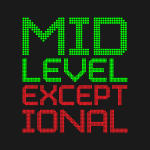CBA Roundtable: The Mid-Level Exception
Welcome to another CBA Roundtable! We talked previously about the connection (and lack thereof) between the rookie scale and the salary cap but the Mid-Level exception provides a different and potentially more compelling issue since it has become such a frequently-used way for certain teams to get better but does not affect a group of players or teams equally.
What do you think about the MLE and whether it should tie directly to the amount of the salary cap?
Jared Dubin (@JADubin5):
Quick thoughts:
As long as the rookie scale is fixed, so too should be the Mid-Level exception.
Seth Partnow (@SethPartnow):
The biggest issue with the Mid-Level exception under the current Collective Bargaining Agreement is how it stealthily introduced a hard salary cap into the system. Certainly, the hard cap does not go by that name but “luxury tax apron” doesn’t sound quite so ominous, does it? In the reckoning that followed the disastrous (from the players’ standpoint) 2011 lockout and subsequent negotiations, the lie of the Hunter regime’s claim to have won a a small victory by avoiding such a hard cap was likely discovered fairly quickly. If there is one change that should be made to the MLE system, it would be decoupling it from the “hard cap” “apron” “airlock” or whatever terminology is chosen this time around to represent the upper bound of player salaries. Beyond that, changes in the level of the MLE relative to the individual max and rookie scale is something of a quibble over details. Especially with the next round of negotiations slated to occur sometime during the upheaval caused by the new media deal money being dumped into the NBA ecosystem like propane on a bonfire, it’s hard to even predict what any sort of natural equilibrium for the various strains of Mid-Level exceptions might be.
Bryan Toporek (@btoporek):
I’m going to slightly disagree with Jared here and say that under the new CBA, our eponymous exception should be tied to the salary cap regardless of what happens with the rookie scale.
This year, the Non-Taxpayer Mid-Level exception ($5.305 million) constitutes roughly 8.4 percent of a team’s cap space. By 2016-17, when the cap is projected to exceed $80 million, the Non-Taxpayer MLE that year ($5.628 million) will be just 7.0 percent of a team’s cap space, assuming an $80 million cap. Thus, teams that ink players under the MLE between now and 2017 — when either the players’ union or the owners are virtual locks to opt out of the current CBA — will be taking advantage of a system that somewhat screws mid-level players for the next few years.
Granted, no intelligent agent should allow any of his or her clients to sign a mid-level contract that extends beyond the 2016-17 season, given the labor battle that lies ahead. Even if the MLE is not tied to the cap under the new CBA, each year’s set amount is bound to be renegotiated. (Currently, the annual MLE values are set through the 2020-21 season, with $6.335 million as the 2020-21 amount.)
Ultimately, is there any reason not to tie the MLE to the cap? Both sides should agree that the non-taxpayer MLE should represent 8 percent of the salary cap each year, while the taxpayer MLE should be somewhere in the 5 percent range. (This year’s taxpayer MLE, $3.278 million, is about 5.2 percent of the salary cap.) That way, if the league experiences any other unexpected spikes in value — perhaps local TV revenue begins skyrocketing thanks to the new national TV contract — the players are in position to reap the rewards without having to rip up another CBA.
And if the players’ union is concerned about a year in which the league’s salary cap falls, which would thus deflate the value of the MLE from the year prior, both sides could simply agree that the value of the Non-Taxpayer and Taxpayer MLE cannot be smaller than the value from the previous year. That would slightly skew the percentage of cap space both MLEs consumed but it would not be too dramatic a departure from the current system where MLE value is not tied to a certain percentage of the salary cap.
Jared Dubin:
I really like Bryan’s idea, if they decide to do the same thing with the rookie scale. Rather than having fixed amounts for rookie contracts without knowing what the cap will be for each given season, assign each slot in the draft a specific percentage of the cap. Then do the same for the full and mini-MLE.
I just do not like the idea of capping rookie salaries at a fixed amount but letting literally everything else fluctuate according to the cap.
Daniel Leroux (@DannyLeroux):
There is an argument for not tying the Mid-Level exception to the cap but it toes a different line than we are used to hearing from the parties, at least publicly. At its most basic, the MLE serves the purpose of providing an avenue for teams over the cap to get better. As an exception, it has limited use for franchises under the cap, sometimes zero use whatsoever like for teams deeply under the cap like the Sixers.
Unlike the rookie scale which applies to every player under the umbrella, free agents can choose to sign somewhere else if they feel the mid-level would not pay them enough. Conceptually, a comparatively smaller MLE would provide a comparative advantage to teams with cap space or even just the larger MLE. We actually saw this over the summer with Shaun Livingston- the Warriors had the Non-Taxpayer Mid-Level exception and used that to offer Livingston more than the Nets could pay him.
As such, a system where the Mid-Level exception became less valuable would benefit teams with salary cap space and hurt those who choose to go over the cap and/or into the tax. The league has pushed for paternalistic measures to protect teams from themselves like shorter contracts and stiffer luxury tax penalties before so the argument could be made that another nudge in that direction would only serve to encourage franchises to be more prudent with the contracts they dole out.
Of course, I personally agree with Bryan’s idea though I would like to note that players at the mid-level annual value would be wise to get long-term money if they can unless doing so takes them past their prime thus collapsing the value of their next contract. I also disagree a little with the idea of making sure the MLE has to go up since as we are seeing now the major reasons why BRI goes up and down are pretty well-known so players and teams alike can prepare and plan for it. The impending cap explosion should raise all boats but will mean much more to starters and above because teams will be aiming very high with their newfound flexibility.
Seth Partnow:
Something to consider is that an MLE amount set “too low” will be primarily an avenue for the rich to get richer. In other words, the common practice of contenders signing quality vets to small and even minimum contracts. If the MLE becomes more of a “blue collar exception” than truly mid-level (something we are already seeing to a degree) the only congruence between team interest and player willingness will be the next generation of Shawn Marion-type deals.
Whether this would be considered a feature or a bug of a new system is an open question.
Jared Dubin:
Isn’t the MLE set at any level an avenue for the rich to get richer? It can only be used by over-the-cap teams, which most often (teams like the Knicks excepted) are the teams paying more money for better-quality talent.
Daniel Leroux:
I agree with Jared here- the Mid-Level is always an avenue for the rich getting richer because it is an exception after all.
The only shift would be if it got too close to the minimum (should that rise) but I sincerely doubt that would happen.
Thank you so much to the roundtable participants and readers alike. If you would like to continue the conversation, feel free to write a comment, send us an e-mail at midlevelexceptional@gmail.com or reach out on Twitter (@MLExceptional).


